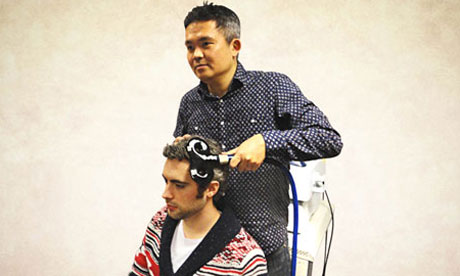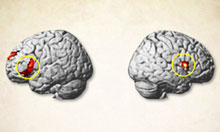I was looking for something else when I found this article on how the brain reacts to good news and bad news.
How the brain filters bad news
We are more likely to be receptive to good news than bad, and a team at UCL has gone some way to explaining why we prefer to look on the bright side

Co-author Ryota Kanai administering transcranial magnetic stimulation (TMS), which sends magnetic pulses into a participant's brain. Photograph: National Academy of Sciences
Most of us go through life with a selective ear for the news we take in. We hear the good more than the bad, the flattering more than the insulting. And we update our beliefs in a way that reflects that bias.
The effect appears in many guises. We update our self image when told we are smarter or better-looking than we thought. But if we hear we are more stupid and uglier than we supposed, we revise that image rather less. In the general population, about 80% to 90% of us behave this way.
 The regions to which TMS was administered. The right inferior frontal gyrus (IFG) is on the right, and the left IFG is on the left. Photograph: National Academy of Sciences
The regions to which TMS was administered. The right inferior frontal gyrus (IFG) is on the right, and the left IFG is on the left. Photograph: National Academy of Sciences
There are pros and cons to what neuroscientists call the "good news/bad news effect", though by the nature of the beast, you might dismiss the negatives. In building beliefs predominantly on good news, we lean towards an optimistic view of life. We are less anxious of the likelihoods of unpleasant events: cancer, burglary, internet fraud, missing a flight, divorce.
There is a cost to this rose-tinted view of the world though. To ignore bad news can be dangerous. It can make us overconfident, perhaps even reckless. It might leave us unprepared for a natural disaster, naive to the dangers of contracting disease, or oblivious to the warning signs of impending financial collapse.
In a series of experiments at University College London, a team of neuroscientists has gone some way to explaining how this preference for good news arises in the brain. Through disrupting the function of a small brain region, they neutralised the bias and left people as open to bad news as they were to good.
Cognitive neuroscientist Tali Sharot and others recruited 30 right-handed people aged 20 to 35 and divided them into three groups of 10. Each received a 40-second blast oftranscranial magnetic stimulation (TMS), which sends magnetic pulses into the head, to disrupt different parts of their brains. In one group, the TMS was aimed at a part called the left inferior frontal gyrus (IFG), in another at the right IFG, and in the third, the target was a control region of the brain, where the pulses were not expected to have much effect.
Within half an hour of the TMS session, participants sat down at a computer which flashed up 40 things nobody wants to happen in their lives, such as developing cancer, having a car stolen, or missing a flight. Each time, the participant had to estimate how likely the event was to happen to them. On typing their answer, the computer displayed the average risk for a person in a similar socioeconomic situation. Estimate your lifetime risk of cancer at one in 10? The average is closer to one in three.
A second session followed. This time, the volunteers were given the same negative cues – cancer, robbery, missing a flight and so on – and had to estimate again the chance that each event would happen to them at some point. The scientists then analysed the answers to see how people's views shifted after they had been given accurate information.
The results were enlightening. Those who had magnetic stimulation to the right IFG, or a control part of the brain, showed the usual good news bias: that is, they updated their beliefs more on hearing good news, such as a lower risk of cancer or Alzheimer's than they originally thought. But stimulation of the left IFG destroyed the bias. Those people were just as likely to change their views based on bad news as good.
"We believe the left inferior frontal gyrus is normally inhibiting other parts of the brain from learning from bad news. But by interfering with the left IFG we're releasing this inhibition," says Sharot, whose study appears in Proceedings of the National Academy of Sciences. A previous study highlighting the brain region appeared last year in Nature Neuroscience.
The left IFG is unlikely to have sole responsibility for the good news bias. The neurons there are connected to many other regions of the brain, and it is hard to stop one part of the brain from functioning without affecting others. The effect more likely arises from a larger neuronal network.
Chris Chambers, a cognitive neuroscientist at Cardiff University, said one surprise was that TMS had such a specific effect, apparently without affecting other aspects of behaviour, such as emotional arousal or attention. "The researchers found no evidence of such effects. Among about a dozen different measures, only the tendency to update beliefs based on bad news was affected by brain stimulation. So for me, as fascinating as these results are, this makes it difficult to understand what brain function has been influenced," he says.
Should we try to base our views more on bad news? Probably not. The good news biastends to be less common in people with depression, suggesting the optimists' view of life is good for our wellbeing and helps to motivate us. And here's where the work might be most use. To understand how the brain goes wrong, it helps first to know how it goes right.